It’s review season again! Theros Beyond Death offers us some new toys for cube owners and I’m excited to get into it with you.
First, Sagas are in fact back. Sagas play out well and their countdown mini-games excellent for limited. There are certainly a few new ones in Theros Beyond Death that have exceeded my expectations after some testing.
In addition we have a fistful of new enchantment gods, remixed from their original incarnations. And perhaps the most important of all is Escape, which has proved itself to be far above even my highest expectations. As it turns out, spells you can cast over and over again—even with some restrictions—can feel broken.
Then there’s constellation, or enchantments-matter. This is the (relatively) parasitic mechanic of the set. Most of these cards won’t make it into our cubes without serious commitments to supporting the archetype. As such, I’ll only be touching on cards which hold an inherent power level and don’t rely on too much on synergy. However, it’s possible that Theros Beyond Death has opened up the possibility of an enchantments-matter archetype in rarity restricted cubes.
I will not be giving out letter grades, but I’ll rate my top cards at the end of the article. We’ll be going in WUBRG color order, then Multicolor and Colorless.
Don’t miss my reviews of White and Black.
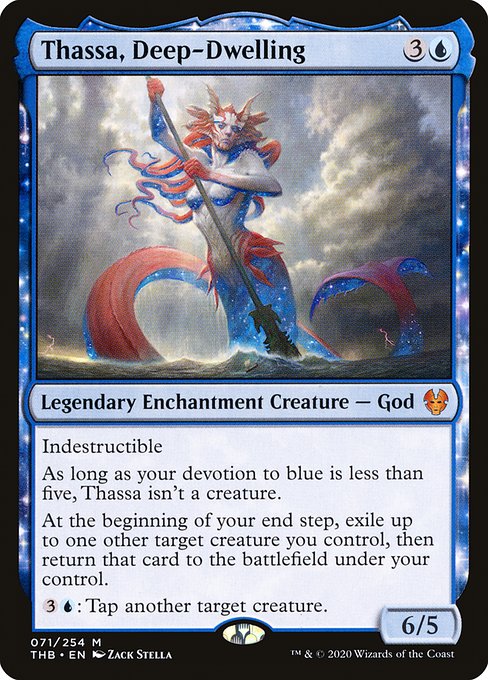
Thassa, Deep-Dwelling
As I stated when reviewing Heliod, Sun-Crowned these Gods should be considered enchantments first. Thassa, Deep-Dwelling acts a little like Soulherder and, as a lover of blink archetypes, reeeeeally wanted this card to work. The truth is, well, Thassa is not only bad, but unnecessary. Turn four is a pretty serious turn in cube, and for Magic in general, so to invest that turns worth of mana on an enchantment with a sometimes-relevant function is not desirable. Take a look through what else is available that blinks our creatures in Azorius: Soulherder, Venser, the Sojourner, Brago, King Eternal, Flickerwisp, Restoration Angel. These cards can affect the board in a meaningful way. Thassa can’t, and that’s a big deal.
I would rather play basically any other Blue card than Thassa, Deep-Dwelling on turn four most of the time. Sure, there’s times she’ll come down and get you some value by blinking something, but measure that against how often she comes down and does nothing at all. And that activated ability? Compare this to Thassa, God of the Sea, who comes down a full turn earlier, lets you Scry, and can make your creatures unblockable for only two mana. I can barely find a place for God of the Sea in my cube and she is so much better than Deep-Dwelling.
Don’t play this card in your cube, however excellent it might be in draft.
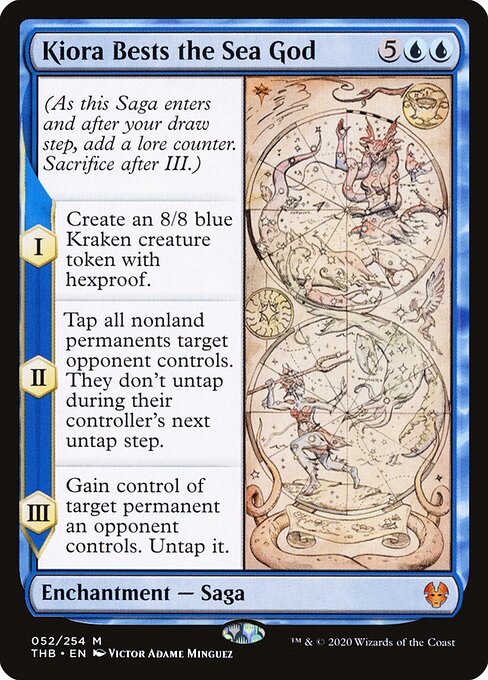
Kiora Bests the Sea God
Seven mana is a helluva lot of mana, and If i’m going to invest this much of it into a non-scalable threat in cube it’d better win me the game. There’s little-to-no room for big spells in our cube decks, so when we can similarly cast Karn Liberated at seven mana the payoff for Kiora Bests the Sea God just isn’t there. Aside from the obvious “died before I could cast it” seven-drop affliction, this card is just too slow to get going; Chapter I’s 8/8 Hexproof Kraken is indeed big, but doesn’t guarantee to stabilize a board state. Chapter II can be effective in creature-heavy matchups, but it isn’t really until Chapter III hits that we’ll see a real payoff.
Sadly, waiting around for Kiora’s Chapter III doesn’t guarantee you’ll win the game either. Threats and answers are too good these days in most cube environments; we just don’t need to get to seven mana to cast something worthy of closing the game. And if all you’re really playing to is Chapter III, well, I’d rather cast Lay Claim, Confiscate, or even Mind Control instead.
The bar is simply set too high for a seven mana spell to make Kiora effective, so i’d encourage you to look elsewhere for these payoffs in your cube.
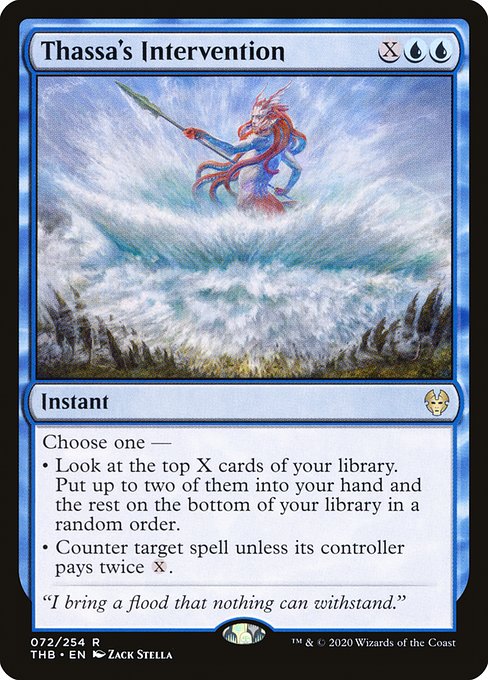
Thassa’s Intervention
Thassa’s Intervention was part of my early impressions article on cards I was excited to try from Theros Beyond Death, and i’m happy to report this card has tested excellently so far. As predicted, flexibility is king; when your Counterspell is also a makeshift Dig Through Time this is almost never a bad draw. Whether ahead or behind there’s applicable use for your Thassa’s Intervention, even if it means casting Weave Fate to find you more action.
Yes, both modes are slightly overcosted, by one mana exactly, but it’s an acceptable balance of the card’s design. When combining two powerful effects that play incredibly well together, the extra mana is well worth the cards adaptability. I think you’ll be happy running Thassa’s Intervention over a big draw spell or a situational counter, as you’ll now have both effects on a single card. I’m becoming more and more convinced that so long as the power level lines up with the designers intended play experience, cards which scale well with the game are just perfect for cube.
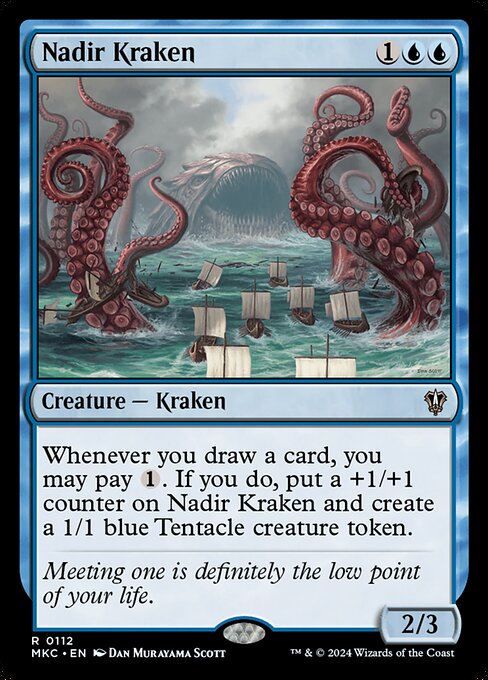
Nadir Kraken
Ah, Nadir Kraken. How do I love thee? Let me count the ways.
But seriously, this card slaps. Nadir Kraken usually plays out like an “army in a can” and does so very effectively. In fact, the only real concern I’ve even had with the card is the one mana tax required to get the requisite tentacle and +1/+1 counter. But after playing with Nadir Kraken enough I believe the tax to be mostly negligible. Now, before you barrage me with stories of whatever circumstances choking you on resources prevented you from getting value, I know. It’s not always going to be possible to pay for the activation. However, skipping a turn during the developing stages of a game because you have something better to do isn’t a problem. This isn’t forcing you to play off curve. You are.
Draw this card early and you have a game ending engine with minimal investment. Draw it late and it’s admittedly a bit underwhelming without ways to draw extra cards. With a little planning and, really, just doing Blue things Nadir Kraken promises to impress. It wouldn’t shock me to see this as a cube staple going forward.
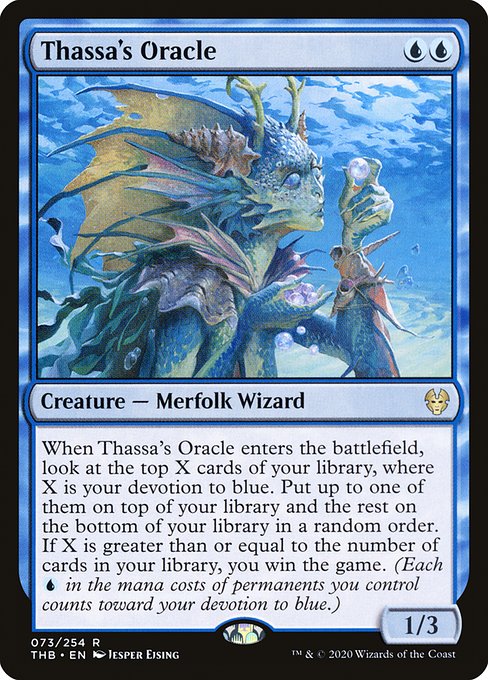
Thassa’s Oracle
Regardless of how you might feel about this, it’s exciting to see new cards that promise legitimate alternate win conditions. Thassa’s Oracle is already a slam dunk in several constructed formats, and it’s possible that for cube we can finally stop everyone from playing Augur of Bolas. The front side of this card is mediocre, good enough to be an acceptable defensive body that comes with a little tacked on card filtering. Put Thassa’s Oracle in a control deck alongside some incidental self-mill or reanimation and we have a surprisingly functional game plan.
Thassa’s Oracle is A + B most of the time, as unfortunately digging through your entire deck does take a while and you’re never guaranteed to stay alive in the process. Most i’ve talked to about Oracle also run Jace, Wielder of Mysteries and, like we’ve seen in Pioneer, combining the two cards into a reasonable control shell makes attacking the opponent finally a thing of the past. I like this approach, mostly because I like Jace, Wielder of Mysteries so much; but the inclusion of Thassa’s Oracle gives the average control deck a “good early, good late” play to that will sometimes randomly win in the late game.
It’s exciting to build with and play to, and for a lot of control lovers out there Thassa’s Oracle can even be a stipulation, a game within a game. Most of the time, I think, it’ll be no more than a small defensive body and that’s okay, too. Again, flexibility is king, and I think we get enough of that here to warrant Oracles inclusion.
Medomai’s Prophecy
Sagas are back, as the advertisement we’ve seen since the release of Theros Beyond Death says. Medomai’s Prophecy I had initially written off as being too durdley but have surprisingly come around to after some testing. The card isn’t spectacular or anything, it’s essentially a two mana Divination, but that’s exactly why I like it. It’s cheap, gets you a little value on the way in, and the predictive nature of Chapter II into Chapter III hasn’t created any awkward sequencing yet. I’m sure there will be circumstances where you’re in a bind and can’t spend the turn cycle waiting to cast the prophecized spell; but so far those sequences have been the outlier, and not the average case.
Still, is it good enough to run in cube? I think rarity restricted envrionments like Peasant will find a home for Medomai’s Prophecy. Being a permanent means the possibility of bouncing or recuring the saga from the graveyard is a play pattern not too difficult to build around, either. It’s not broken, not exciting, but solid and the unique nature of Sagas usually make for interesting gameplay.
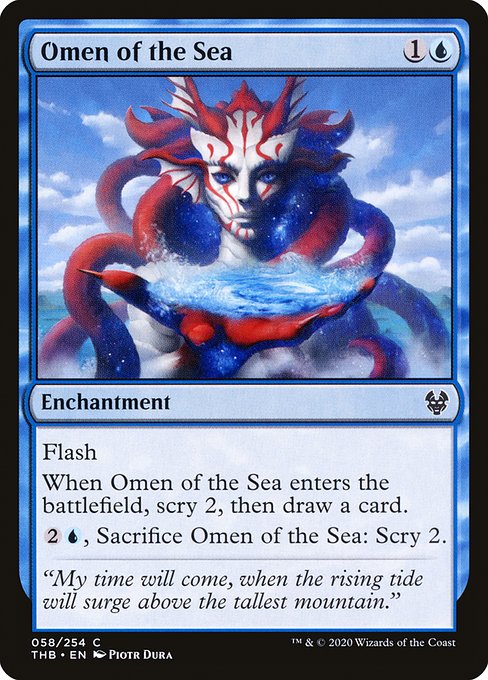
Omen of the Sea
Now here’s something to be excited about! Omen of the Sea is the new cantrip on the block and really delivers. Casting Preordain at instant speed is good and worth the extra mana, especially while holding up countermagic. Being a permanent means we can flicker or bounce it, which i’m heavily incentivized to do with such a powerful effect. And the sacrifice activation for an additional Scry 2 is just gravy, text that I wouldn’t miss if it was never on the card in the first place. As a cantrip, this is one of the better newly printed ones we’ve seen in a while, and as something we can interact with, well that’s just value.
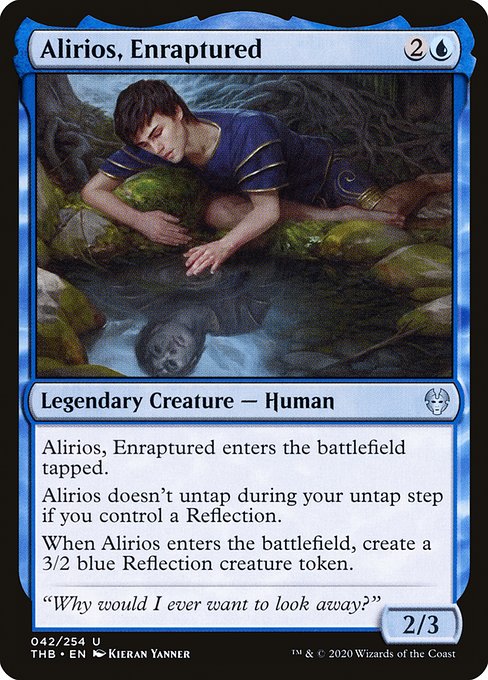
Alirios, Enraptured
Similar to Blade Splicer, Alirios, Enraptured providing two bodies is, quite simply, a three mana two for one. Sure they can’t both block or attack right away, but the raw numbers we get for our mana absolutely make up for it. This is a juicy creature for any flicker/skies archetype, so I think Alirios is perfectly suited for Peasant cubes. It’s also a legend, for whatever that’s worth.
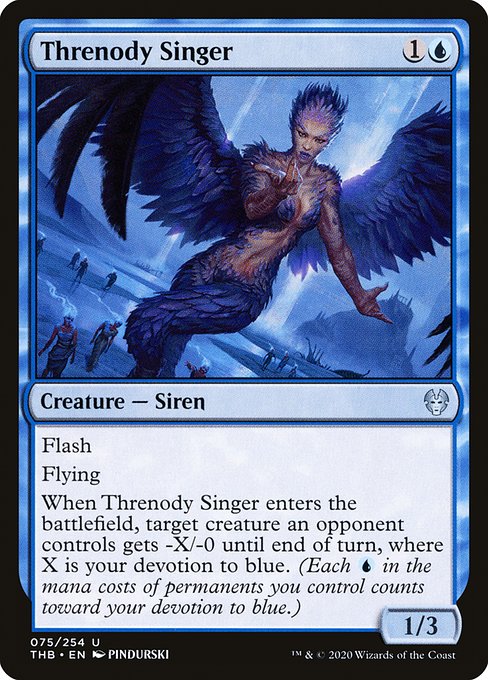
Threnody Singer
First there was Faerie Duelist, and a year later we get Threnody Singer. These are very similar cards, but with one key difference. Threnody Singer is slightly bigger at the back, and they’re ability scales up the longer and more complex the game becomes. This is a perfect card for an aggressive skies or Blue-based tempo deck, and slots well into Peasant cubes where those archetypes are supported.
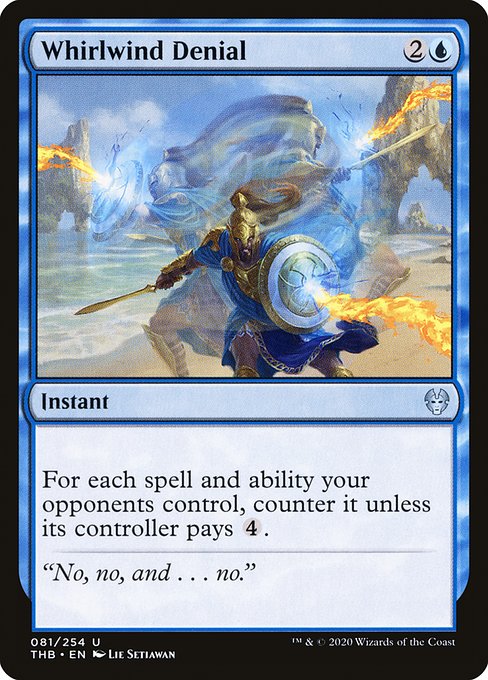
Whirlwind Denial
Whrilwind Denial is a unique counterspell, one that interacts not only with spells on the stack, but abilities too. It reminds me of Summary Dismissal somewhat, except the “all” becomes relevant to only our opponents. Four mana is a huge tax to pay for most spells and abilities, so if there’s a stack waiting to resolve, expect Whirlwind Denial to favorably clean it up for you. The agency we have to interact with abilities is the key to Whirlwinds power, one that makes me wonder if it’s good enough to play alongside more powerful, efficient countermagic.
I admit I haven’t tested this card yet, but I intend to. Like I keep saying, flexibility is king, and we get access to this with Whirlwind Denial. It might be too inefficiently costed, but i’ll have to get back to you after I see it in action.
Power Rankings—Blue
Powered/Legacy
Peasant
- Omen of the Sea
- Alirios, Enraptured
- Medomai’s Prophecy
- Whirlwind Denial???
- Threnody Singer
Blue gets some very powerful cards this time around, including a playable alternate win condition. I’m excited to continue playing with all of these cards. Next week we go over Black. Until then, Happy Cubing!

